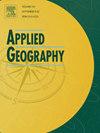从15分钟步行的角度探讨街道景观对内涝风险的影响
IF 5.4
2区 地球科学
Q1 GEOGRAPHY
引用次数: 0
摘要
了解街道景观对内涝风险的影响对于增强城市抗灾能力至关重要。本研究利用街景图像和导航数据,应用可解释机器学习技术,研究了居民区15分钟步行半径内内涝概率和主导因素的空间变异性。以北京主城区为研究对象,研究结果显示,在距内涝点150米范围内,建筑物的影响最大,其次是墙壁和道路,而人行道和植物的影响最小。道路、墙壁、建筑物和人行道等街景对内涝风险的影响呈倒u型趋势,而天空和植被(尤其是草地)对内涝风险的影响显著降低。主导因素在空间上存在差异:在机场和铁路附近地区,密集的建筑物增加了内涝风险,而墙壁和开阔的天空则减轻了内涝风险;在东部商业区,墙壁和天空是内涝的主要原因,但草缓解了内涝;在分散的地区,开放的天空降低了风险,而建筑物加剧了风险;在北部外围,分散的建筑和墙壁有助于减少内涝;在五环沿线,城墙、天空和树木发挥了更大的作用。从空间上看,高风险区域主要集中在主干道沿线,特别是南部的三环和四环之间,形成u型格局,而靠近二环的地区风险较低。这些发现为城市规划、街道景观设计和内涝防治策略提供了可操作的见解。本文章由计算机程序翻译,如有差异,请以英文原文为准。
Exploring the impact of streetscapes on waterlogging risk from a 15-minute walkability perspective
Understanding the impact of streetscapes on waterlogging risk is critical for enhancing urban resilience. This study uses street view images and navigation data to investigate the spatial variability of waterlogging probability and dominant factors within a 15-min walkable radius of residential communities, applying interpretable machine learning. Focusing on Beijing's main urban area, the results reveal that within 150 m of waterlogging points, buildings have the greatest impact, followed by walls and roads, while sidewalks and plants play a minimal role. Streetscapes such as roads, walls, buildings, and sidewalks exhibit an inverted U-shaped trend in their impact on waterlogging risk, whereas sky and vegetation, particularly grass, significantly reduce the risk. Dominant factors vary spatially: in areas near airports and railways, dense buildings increase waterlogging risk, while walls and open sky mitigate it; in the eastern business district, walls and sky are the main contributors to waterlogging, but grass alleviates it; in decentralized areas, open skies reduce risk, while buildings exacerbate it; in the northern periphery, dispersed buildings and walls help reduce waterlogging; and along the Fifth Ring Road, walls, sky, and trees play a stronger role. Spatially, high-risk zones are concentrated along major roads, particularly between the 3rd and 4th Ring Roads in the south, forming a U-shaped pattern, while areas near the 2nd Ring Road show lower risk. These findings provide actionable insights for urban planning, streetscape design, and Waterlogging prevention strategies.
求助全文
通过发布文献求助,成功后即可免费获取论文全文。
去求助
来源期刊

Applied Geography
GEOGRAPHY-
CiteScore
8.00
自引率
2.00%
发文量
134
期刊介绍:
Applied Geography is a journal devoted to the publication of research which utilizes geographic approaches (human, physical, nature-society and GIScience) to resolve human problems that have a spatial dimension. These problems may be related to the assessment, management and allocation of the world physical and/or human resources. The underlying rationale of the journal is that only through a clear understanding of the relevant societal, physical, and coupled natural-humans systems can we resolve such problems. Papers are invited on any theme involving the application of geographical theory and methodology in the resolution of human problems.
 求助内容:
求助内容: 应助结果提醒方式:
应助结果提醒方式:


